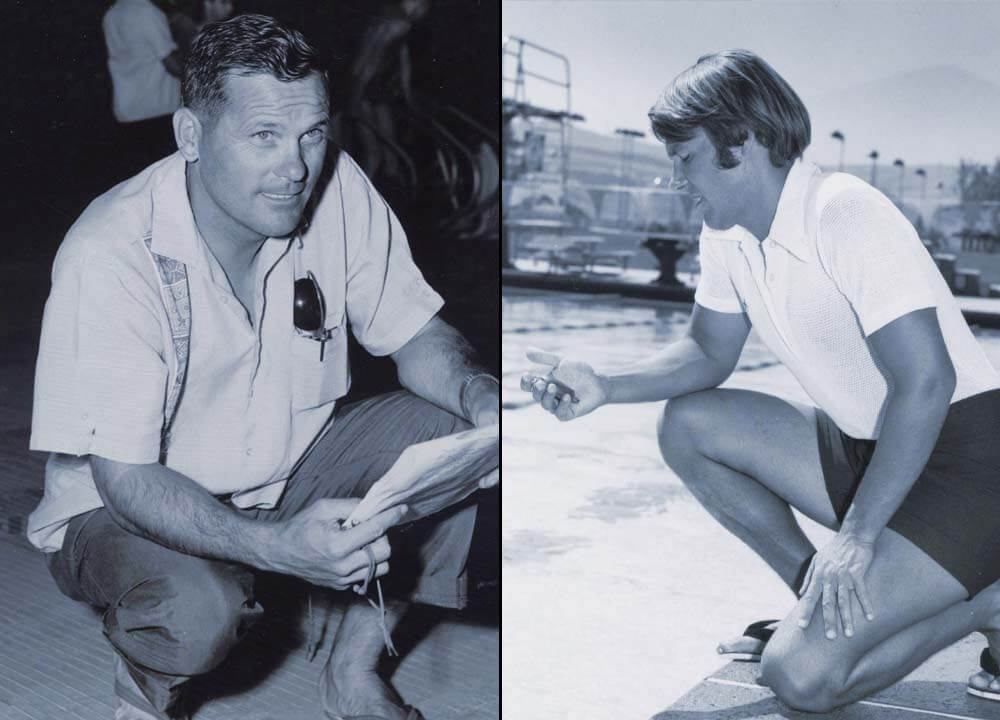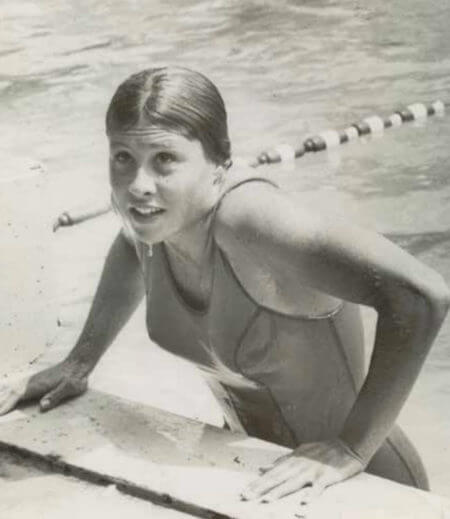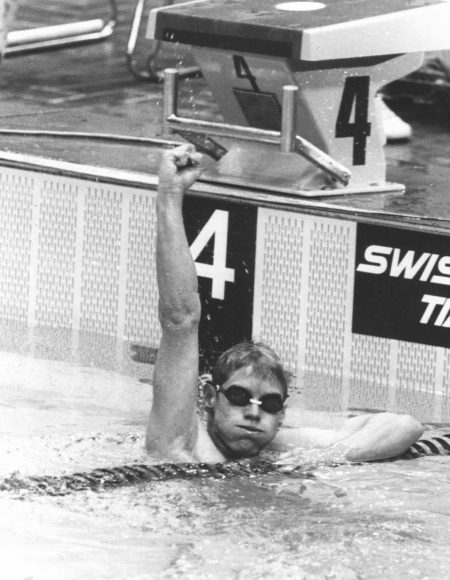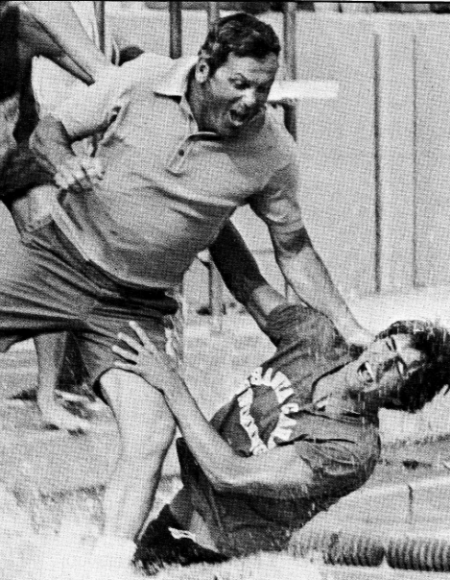The Golden Years of High School Swimming: Santa Clara and Mission Viejo (Full Story)

The Golden Years of High School Swimming: Santa Clara and Mission Viejo (from September’s Swimming World Magazine)
Public schools Santa Clara and Mission Viejo built high school swimming dynasties from the 1960s through the early 1980s. Not only did they dominate high school swimming, but unlike today, they also produced many of the swimmers from that era who competed in the Olympics.
**********
Of the entire U.S. swim team assembled for the 1964 Olympics in Tokyo, 13 of them had trained in one pool—at Santa Clara High School in northern California under Coach George Haines.
Among Haines’ swimmers at the 1964 Olympics, Don Schollander was the star of the Games, winning gold medals in the 100 and 400 free along with two free relays, and Dick Roth and Donna de Varona earned the inaugural Olympic gold medals in the men’s and women’s 400 IM.
By today’s norms in swimming, a club team of high school-aged swimmers packing an Olympic team would be stunning, but in the 1960s, no college scholarships existed for female swimmers, and there were no professional opportunities beyond college for men. Therefore, the patience and steady development that today’s coaches practice for their young swimmers would have been worthless. Teenage swimmers had to take advantage of their brief window to excel.
George Haines: Great Coach, Teacher and Person
And to give themselves the best chance at excelling, they turned to Haines, who coached a then-small Santa Clara Swim Club and the Santa Clara High School team. Haines also worked as a high school P.E. instructor, and he had previously also coached the high school lightweight football team.
Schollander moved from his home in Oregon to live with a family in Santa Clara so he could swim for Haines. While living apart from his family, Haines became a father figure for Schollander. On weekends, Schollander would accompany Haines to coaches’ clinics as a demonstrator, and the two bonded during that time. On deck, Haines would quickly adapt and react to fit the needs of his swimmers on a daily basis, and he would vary his workouts to keep his swimmers mentally fresh.
“A lot of coaches just write the workout on the blackboard and then just sit there. He was very, very involved, not only motivating us, but he was always correcting in our stroke technique. I had a tendency to drop my left elbow on freestyle. He would just look at me and touch his elbow,” Schollander said. “Just a great, great coach and a great teacher, great person. That’s what he was.”
De Varona, who had qualified for the 1960 Olympics as a prelims relay swimmer, spent the following year at Acalanes High School, where her brother was a senior, for a “normal” high school experience, but after that, she moved from the Berkeley, Calif., area to the South Bay and Santa Clara so she could swim full time with Haines.

Donna de Varona — Photo Courtesy: Swimming World
During her three years swimming at Santa Clara, de Varona said, “We broke world records in workout.” Typically, she would swim with the superstar boys in the group except during the boys-only high school swim team, when that was not allowed. The girls would sit in the stands and cheer on the boys in high school competition, and then, during the summer, the group would train together in elite-only morning workouts.
In 1962, de Varona traveled to Osaka, Japan, where she roomed with fellow American Sharon Finneran and raced Finneran in the 400 IM—and the two repeatedly traded the world record, with Finneran ending up with the final record at 5:21.9.
Shortly after that, Finneran, now Sharon Finneran Rittenhouse, decided that she, too, wanted to swim with Haines at Santa Clara, where she would be training with everyone she would need to beat to make the Olympic team. (Claudia Kolb, the next world record holder and the eventual Olympic gold medalist in both the 200 and 400 IMs in 1968, was also training in Santa Clara.) De Varona eagerly accepted the arrangement, believing that the two would make each other better as rivals training together. So Finneran moved from Los Angeles by herself, without her family, to Santa Clara.
When she arrived, Haines put Finneran with the male distance swimmers, while de Varona swam on the other side of the pool in the middle-distance workout, so the two did not race each other every day in practice.
“We could still compete every day and not have a head-to-head competition,” Finneran said. “He was able to soften that whole competitive thing so that all of us could swim in the same pool and not be enemies and not have that stress of every single day having to go head on with the person you had to beat to make the Olympic team. He was remarkable for that. It was a genius the way he did his workouts so that everybody was able to be comfortable.”
In the potentially anxious environment, Haines could masterfully defuse tension and break up the monotony of tough practices. He often flipped chairs with his feet, offering swimmers the chance to get out of practice if he failed to land the chair straight up. Schollander recalled one time during the summer when he jumped into the pool fully clothed after Kolb put up an impressive practice effort. He would solicit opinions from his swimmers and from other coaches and incorporate them. And he had an ability to make each swimmer feel special, as if they were his favorite.
“George had a knack for, before the race, even if your rival was your teammate, making you think that he wanted you to win,” de Varona said. “I would never tell Sharon what George told me, and Sharon would never tell me what George told her. But years later, we were laughing over it because I thought I was his favorite, and Sharon thought she was her favorite. George had that ability.”
And the pattern of immense success continued: Haines would put an amazing 16 swimmers on the 1968 Olympic team, with Kolb, Jan Henne and Mark Spitz all winning gold medals, and another 10 swimmers on the 1972 team, when Spitz won his then-record seven gold medals.
Mission Viejo: Following in Santa Clara’s Footsteps
In 1972, Mark Schubert first moved from Ohio to California as head coach of the Mission Viejo Nadadores. For years, he had read about Haines and his high school and club teams at Santa Clara, and he aspired to put together a similarly successful program. And indeed, Mission Viejo became the high school swimming mecca of the 1970s and 1980s, just like Santa Clara a decade earlier.
When Swimming World began naming national high school teams of the year in 1971, Santa Clara won four of the first five (boys’ titles), and then, the Mission Viejo girls and boys each won a whopping ten public school titles each between 1977 and 1987.

Photo Courtesy: Don Chadez
A year after beginning his tenure with the Nadadores, Schubert started coaching the high school team as well, and Mission Viejo took second at the CIF (California Southern Section) Championships behind the efforts of a freshman named Brian Goodell. The following year, Mission Viejo won the first CIF title in the school’s history. At that meet, Schubert said, “Brian Goodell and Tim Shaw raced head-to-head in the 500, and they were both under the current American record. This wasn’t NCAAs. This was CIF high school kids. Of course, both of those kids ended up making the Olympic team two years later.”
After that, the CIF passed a rule where a coach could not work with his high school athletes out of season, so he had to choose between his club and high school coaching jobs. Although the Mission Viejo High School principal offered him a teaching job so he could continue coaching for the school, Schubert picked club. He recommended a coach named Mike Pelton to take over the high school team, and his stronger swimmers continued to train with the club team during the high school season.
The high school team kept winning, and Schubert encouraged all his swimmers to swim for their high schools, maybe skipping some easier meets during the season, but always gearing up for the league meet and the CIF championship. Some, including Shirley Babashoff, attended other area schools, but Goodell, Jesse Vassallo and Dara Torres were among those who swam at Mission Viejo High School.
“I got involved with swimming as a high school swimmer in Akron, Ohio. I’ve always had a love for high school swimming,” Schubert said. “I think it’s a valuable experience. I think the team aspect, swimming for your high school classmates and swimming for your school, it’s kind of like swimming in college, and I want them to have that experience.”
Goodell remembers his senior year in high school, 1977, when Mission Viejo won its first national team of the year honor. The team had set a goal to dominate Swimming World’s mythical competition, and Mission Viejo High School even held a pep rally for the swim team before the CIF meet. Even with their sights set on even higher ambitions in swimming, proving their mettle as the country’s best high school swim team had major value.
“It was a stepping stone to bigger and better things, like college scholarships and NCAA Championships and Pan American Games and the Olympic Games,” Goodell said. “I don’t think it was the be-all, end-all in any case, but it was a byproduct of the fact that we had bigger goals and were working hard to be the best in the world.”
Vassallo, meanwhile, moved from Puerto Rico to Florida and then to Mission Viejo in 1975 when he was 14. His father moved the family to California “strictly for swimming,” and he called swimming for Schubert and with swimmers like Goodell a “heck of an experience.” While still in high school, Vassallo won gold medals in the 200 back and 400 IM at the 1978 World Championships. From high school competitions, Vassallo’s standout memory is “the way we dominated,” he said.
“We could do pretty much whatever we wanted,” Vassallo said. “If we wanted to go 1-2-3-4-5-6-7-8 in the 500 free, we could have packed it up. Relays, we could have had the two relays. It was pretty impressive. It felt pretty powerful to be a part of it.”
Meanwhile, the Mission Viejo Nadadores became the country’s top club team, with a pre-eminent goal of winning U.S. Nationals and putting swimmers on the Olympic team. “We even had T-shirts that said, our motto was, ‘Think Nationals.’ In those days, we didn’t have Junior Nationals,” Goodell said. “It was either you made Nationals or you went to Junior Olympics. That was it. I didn’t want to get left behind. I got left behind on the team going to Nationals in 1973. They all got out of the pool to go to the airport. That felt bad. I didn’t want to be left behind again.”
Six Nadadores qualified for the U.S. Olympic team in 1976, along with several more international swimmers who had moved to Mission Viejo to train, from countries like Great Britain, Australia, Brazil and the Netherlands. Still in high school, Goodell won gold in the 400 free—edging out Shaw and reversing the CIF finish from a few years earlier—and 1500 free, and he smashed world records in both events. Following that success, more top swimmers began moving to Mission Viejo to train with Schubert, and the Nadadores kept putting more swimmers on Olympic teams, with four qualifying for the U.S. team for the 1980 Games and six in 1984.
A New Era of Swimming

George Haines and Mike Bottom, now the coach at the University of Michigan, celebrate Haines’ final CIF title — Photo Courtesy: Bob Goff
The 1960s was the era of Santa Clara, and in the late 1970s and early 1980s, Mission Viejo became the center of the American swimming universe. In the contemporary swimming era, it’s rare for many of the best high school swimmers in the country to train together in one place.
“I think there are more good coaches and good programs around the country, and I think that’s really helped American swimming a lot,” Schubert said.
And at the same time, the sport has become much older. College scholarships did not exist for women until the passage of Title IX in 1972, so swimmers like de Varona basically had no path forward in swimming after high school. Up through the 1980s, even after the Olympic ban on professionals was lifted, no swimmer could afford to swim past college. Unlike today’s age of long, professional swimming careers, this era of high school swimming focused on big success at a young age.
Every swimmer who qualified for the 2016 U.S. Olympic swim team was at least one year past their high school graduation, and while some very young female swimmers have achieved success (like Missy Franklin and Katie Ledecky), no American high school-aged male swimmer has qualified for the Olympics since 2000. So for all the greatness of the Santa Clara and Mission Viejo dynasties, it’s unlikely we will ever again see high school swimmers packing the lanes and training together for their imminent shot at Olympic glory.




Dick Hannula and Wilson High School up here in Washington State.
Great names from the past. Remember following the Bottom brothers
Mark Schubert coached me at Rick Rowland’s Swim Camp and George Haines lead me to Menlo School where I coached water polo ?♂️ for a couple of years.
Gambril City of Commerce SoCal
Kerry Haines Derr have you seen this. HUGS